Working out doesn’t have to mean dragging yourself to the gym, sweating buckets, or jumping around like a fitness influencer.
If you’re looking for simple, effective ways to stay active and strong at home, you’re in the right place.
These 15 easy exercises are perfect for older women who want to move their bodies without overcomplicating things.
No intimidating routines. No confusing equipment. It’s just real movement that makes you feel better, not burned out.
Why Quick, Gentle Workouts Matter
As we age, staying active isn’t about looking like we did at 25—it’s about feeling good, keeping our joints happy, and maintaining strength so we can live life on our terms.
These quick workouts support:
- Better balance and mobility
- Stronger muscles and bones
- Improved mood and energy
- Heart health and flexibility
And the best part? You can do them in your living room—in your comfiest leggings, with your favorite music, or even during commercial breaks.
1. Seated Marches
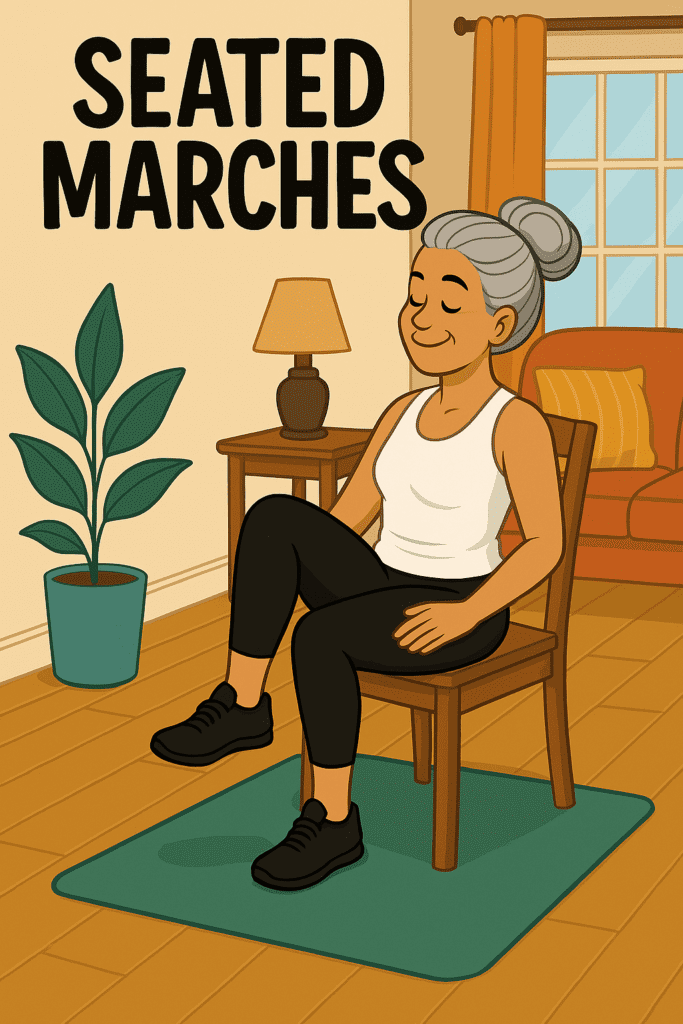
What It Is: A simple, low-impact cardio move you can do from a chair.
How to Do It:
- Sit tall in a sturdy chair with feet flat on the floor.
- Engage your core and lift your right knee as high as you comfortably can.
- Lower it back down and repeat with the left leg.
- Alternate legs in a marching motion for 30–60 seconds.
Why It Helps:
- Boosts circulation
- Warms up muscles
- Improves hip mobility
Make It Easier: March slowly and focus on smaller movements.
Make It Harder: Add light ankle weights or speed up slightly.
2. Wall Push-Ups
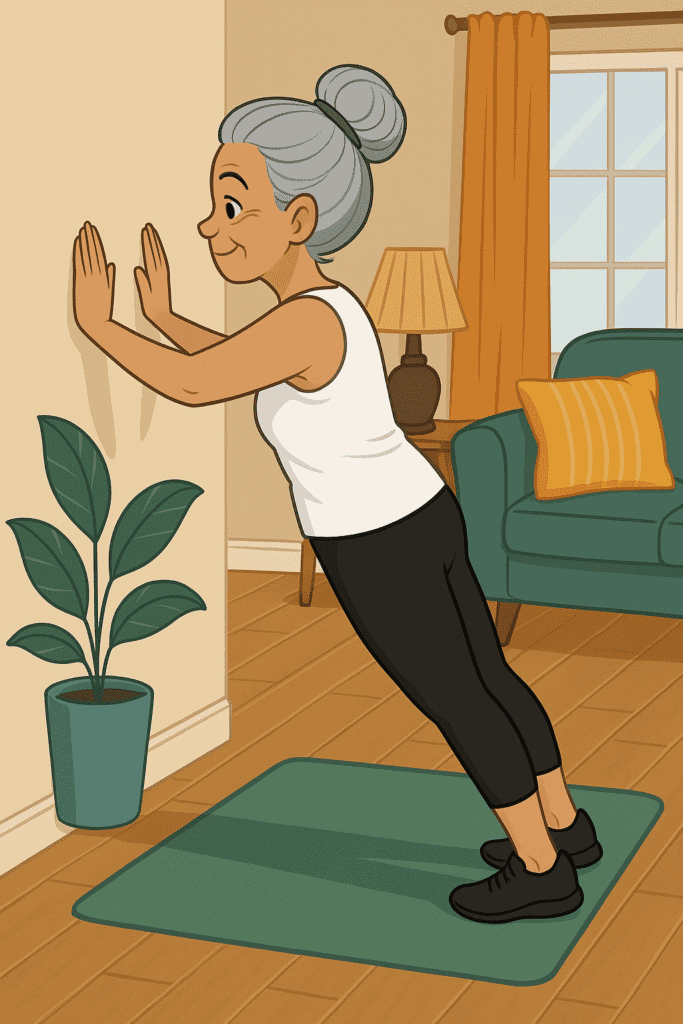
What It Is: A beginner-friendly push-up that strengthens arms and chest without straining joints.
How to Do It:
- Stand facing a wall, about an arm’s length away.
- Place hands flat on the wall at shoulder height and shoulder width apart.
- Keeping your body in a straight line, bend your elbows and slowly lean toward the wall.
- Gently push yourself back to the starting position.
- Repeat 10–15 times.
Why It Helps:
- Strengthens upper body
- Supports shoulder health
- Builds confidence for floor push-ups later
Make It Easier: Step closer to the wall.
Make It Harder: Step back to increase the angle and challenge.
3. Chair Squats
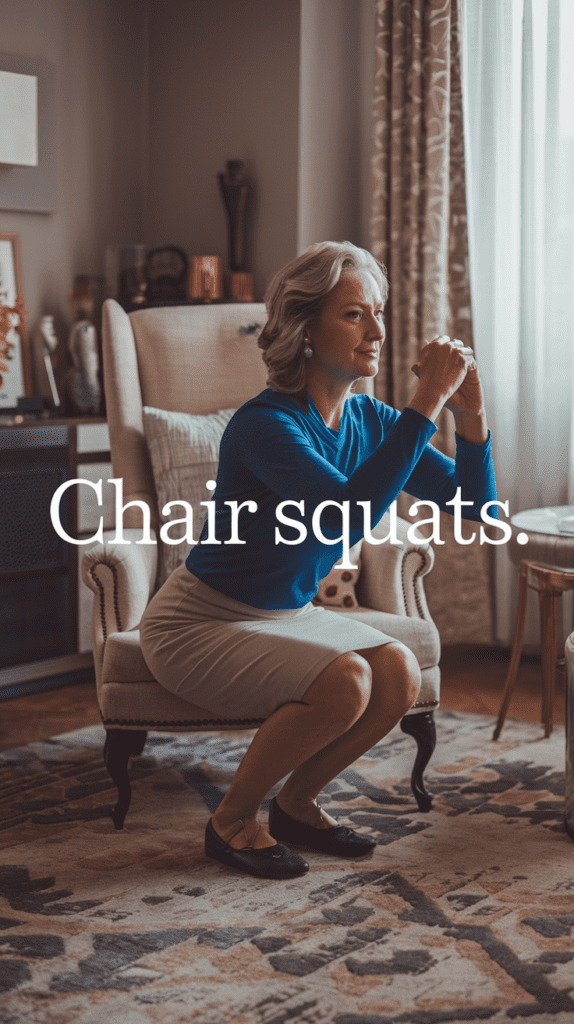
What It Is: A safe way to strengthen your legs and practice getting up from a seated position.
How to Do It:
- Stand in front of a chair with your feet shoulder-width apart.
- Slowly bend your knees and lower yourself like you’re going to sit.
- Lightly touch the chair with your bottom (don’t fully sit).
- Press through your heels to stand back up.
- Repeat 10–12 times.
Why It Helps:
- Builds lower body strength
- Improves balance and mobility
- Mimics everyday movements (like getting off the couch!)
Make It Easier: Use your hands on your thighs for support.
Make It Harder: Hover longer before standing or hold light hand weights.
4. Arm Circles

What It Is: A gentle toning move for shoulders and arms.
How to Do It:
- Stand or sit tall with arms extended straight out to the sides.
- Make small circles with your arms forward for 15 seconds.
- Reverse the direction and circle backward for another 15 seconds.
- Rest and repeat 2–3 rounds.
Why It Helps:
- Increases shoulder flexibility
- Tones arms
- Improves posture
Make It Easier: Lower your arms if tired or take breaks.
Make It Harder: Hold water bottles or light weights for added resistance.
5. Side Leg Lifts

What It Is: A balance-boosting move to strengthen hips and outer thighs.
How to Do It:
- Stand behind a chair, holding the back for balance.
- Shift your weight to your left foot and slowly lift your right leg out to the side.
- Keep your torso straight—don’t lean.
- Lower your leg with control.
- Do 10–12 reps, then switch sides.
Why It Helps:
- Strengthens hip muscles
- Aids in fall prevention
- Enhances balance
Make It Easier: Lift your leg just a few inches—small movements still work!
Make It Harder: Pause at the top for a 2-second hold or add an ankle weight.
6. Toe Taps
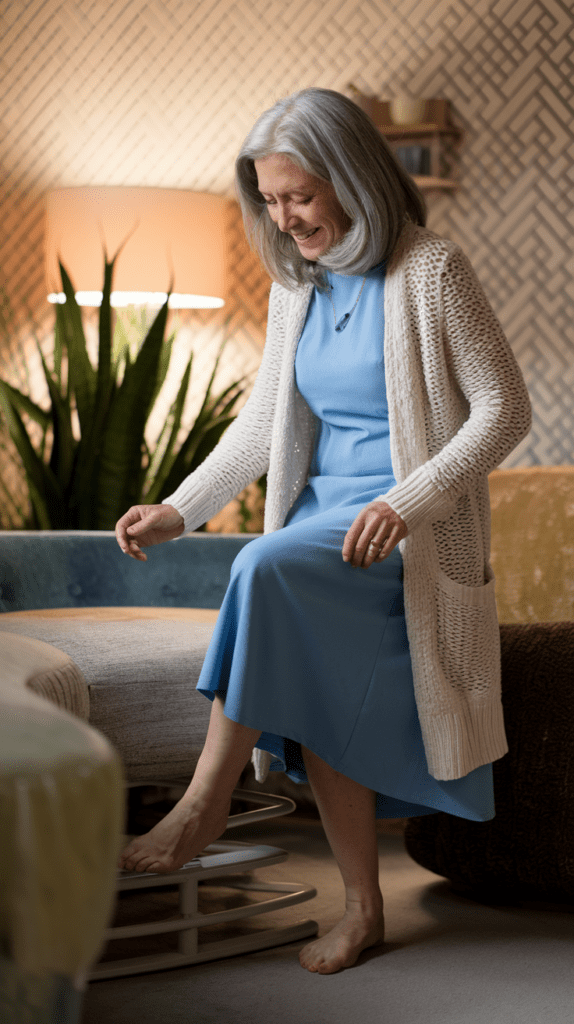
What It Is: A light cardio move to improve coordination and ankle flexibility.
How to Do It:
- Sit upright in a sturdy chair or stand near a wall for balance.
- Extend your right leg and tap your toes lightly on the floor in front of you.
- Bring the foot back and repeat with the left foot.
- Alternate toe taps for 30–60 seconds.
Why It Helps:
- Promotes blood flow
- Gently works the lower legs
- Supports ankle mobility
Make It Easier: Do it from a seated position.
Make It Harder: Increase speed or tap to the side as a variation.
7. Modified Sit-Ups

What It Is: A gentler version of a traditional sit-up that works your core without straining your back or neck.
How to Do It:
- Lie on your back with your knees bent and feet flat on the floor.
- Cross your arms over your chest, or keep them at your sides.
- Engage your core and lift your shoulders a few inches off the mat.
- Slowly lower back down with control.
- Repeat for 8–10 reps.
Why It Helps:
- Builds core strength
- Supports posture and spinal health
- Helps with everyday movement like getting out of bed
Make It Easier:
Can’t get to the floor? Try Seated Core Squeezes:
- Sit tall, tighten your belly muscles for 5 seconds, then relax.
- Do 8–10 rounds.
Make It Harder: Reach your arms forward as you lift for more resistance.
8. Heel Raises
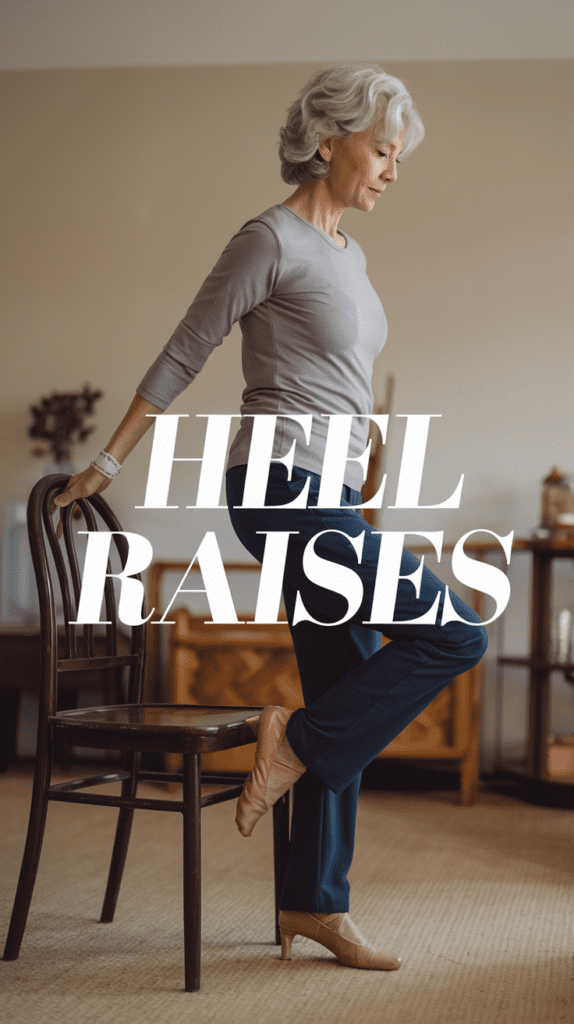
What It Is: A simple way to strengthen your calves and improve circulation.
How to Do It:
- Stand tall and hold onto a chair, wall, or countertop for support.
- Slowly raise both heels off the floor so you’re on your toes.
- Pause for 1–2 seconds.
- Lower your heels back down with control.
- Repeat 10–15 times.
Why It Helps:
- Strengthens calves
- Improves balance
- Aids in blood circulation (especially helpful if you sit a lot)
Make It Easier: Do it while seated for a light version.
Make It Harder: Try single-leg heel raises or hold the top position longer.
9. Overhead Reach Stretch
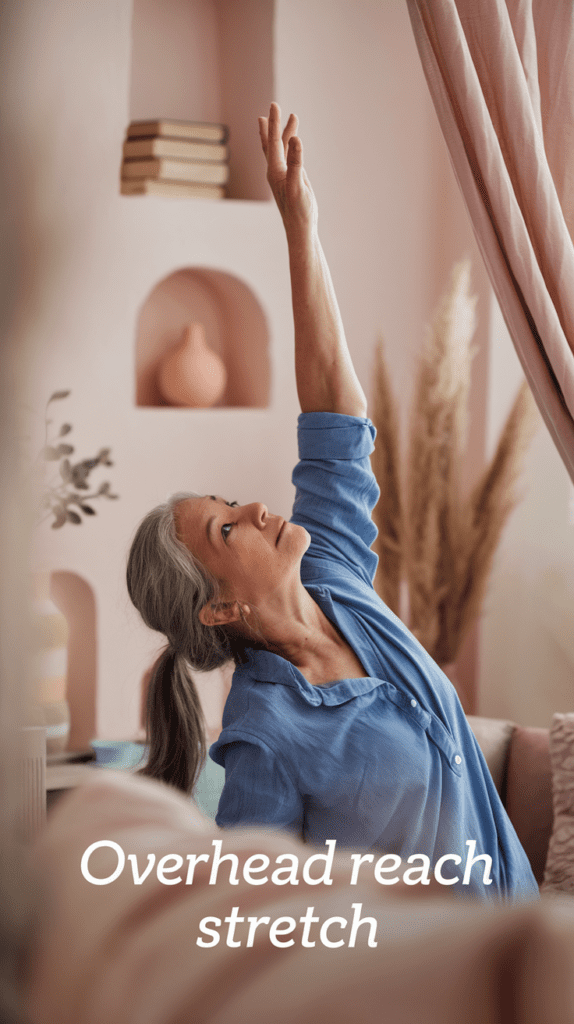
What It Is: A gentle stretch that opens up the upper body and improves posture.
How to Do It:
- Stand or sit with your back straight and shoulders relaxed.
- Reach both arms up overhead as high as you comfortably can.
- Hold the stretch for 10–15 seconds while breathing deeply.
- Slowly lower your arms back down.
- Repeat 3–4 times.
Why It Helps:
- Improves posture
- Increases shoulder flexibility
- Relieves tension from sitting or hunching
Make It Easier: Raise one arm at a time.
Make It Harder: Hold light weights for a strength-building stretch.
10. Cat-Cow Stretch
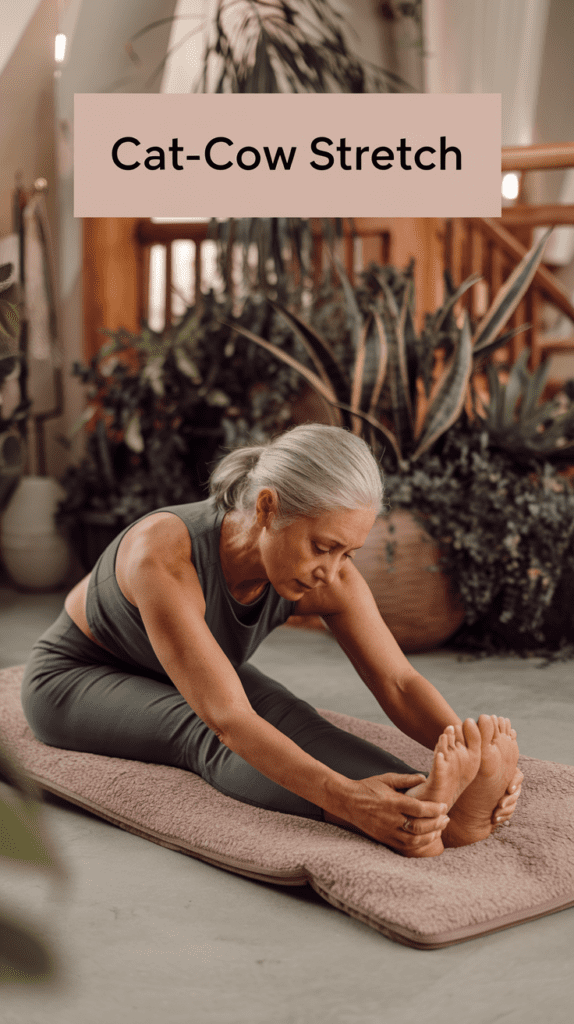
What It Is: A mobility move often used in yoga to gently stretch the spine.
How to Do It (Floor Version):
- Start on your hands and knees with your back flat.
- Inhale and arch your back, lifting your head and tailbone (Cow).
- Exhale and round your back, tucking your chin and tailbone (Cat).
- Flow between these two movements for 30–60 seconds.
Chair Modification:
- Sit on a chair with feet flat.
- Inhale, arch your back slightly, and look up.
- Exhale, round your back, and tuck your chin.
- Repeat 5–6 times.
Why It Helps:
- Enhances spine flexibility
- Reduces back stiffness
- Encourages mindful breathing
Make It Easier: Go slowly and focus on comfort, not range of motion.
Make It Harder: Hold each stretch longer or coordinate with deeper breathing.
11. Neck Rolls

What It Is: A gentle stretch relieves neck and upper shoulder tension.
How to Do It:
- Sit or stand with your spine tall and shoulders relaxed.
- Tilt your head to the right, then slowly roll it forward to the left.
- Make a full circle in one direction, then switch and roll the other way.
- Repeat each direction 3–5 times, moving slowly and gently.
Why It Helps:
- Eases stiffness from sitting or tech use
- Improves neck mobility
- It helps relieve tension headaches
Make It Easier: Keep the movement small and skip any painful ranges.
Make It Harder: Add shoulder shrugs and deep breathing between reps for added relaxation.
12. Step Touches
What It Is: A fun, low-impact movement that raises your heart rate.
How to Do It:
- Stand with feet hip-width apart.
- Step your right foot out to the side.
- Bring your left foot in to meet it.
- Then, step to the left, bringing your right foot in.
- Repeat side to side for 30–60 seconds.
Why It Helps:
- Adds light cardio
- Improves coordination
- It can boost mood when done with music!
Make It Easier: Keep the steps small and slow.
Make It Harder: Add arm movements or light hand weights.
13. Shoulder Rolls
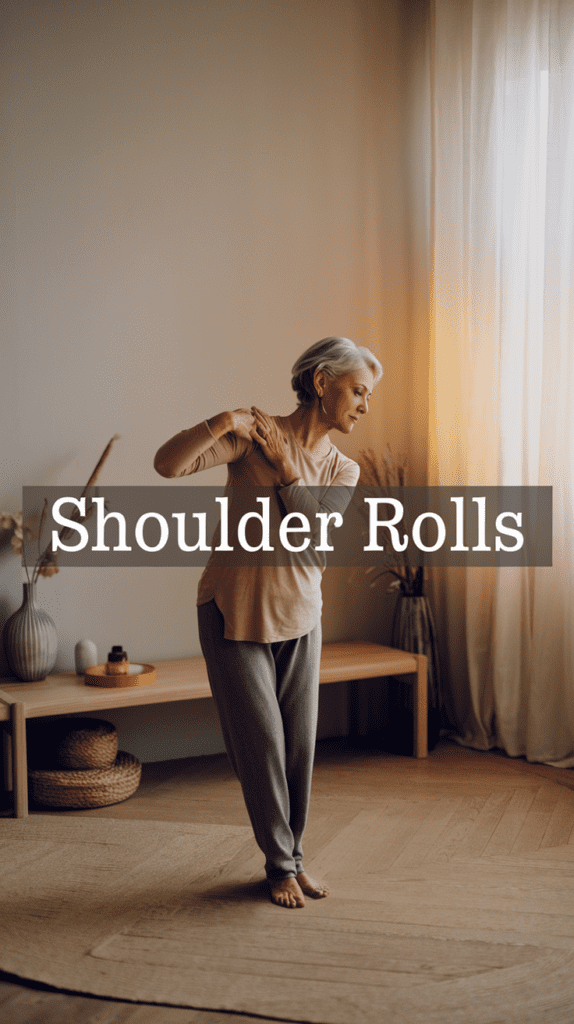
What It Is: A relaxing movement relieves tension and encourages better posture.
How to Do It:
- Sit or stand tall.
- Slowly roll both shoulders forward in a circular motion 5–10 times.
- Reverse direction and roll them backward 5–10 times.
- Breathe deeply as you move.
Why It Helps:
- Relieves tightness from stress or slouching
- Encourages better alignment
- Feels good after a long day!
Make It Easier: Rest between directions or do one shoulder at a time.
Make It Harder: Hold light weights to activate muscles as you roll.
14. Knee Extensions
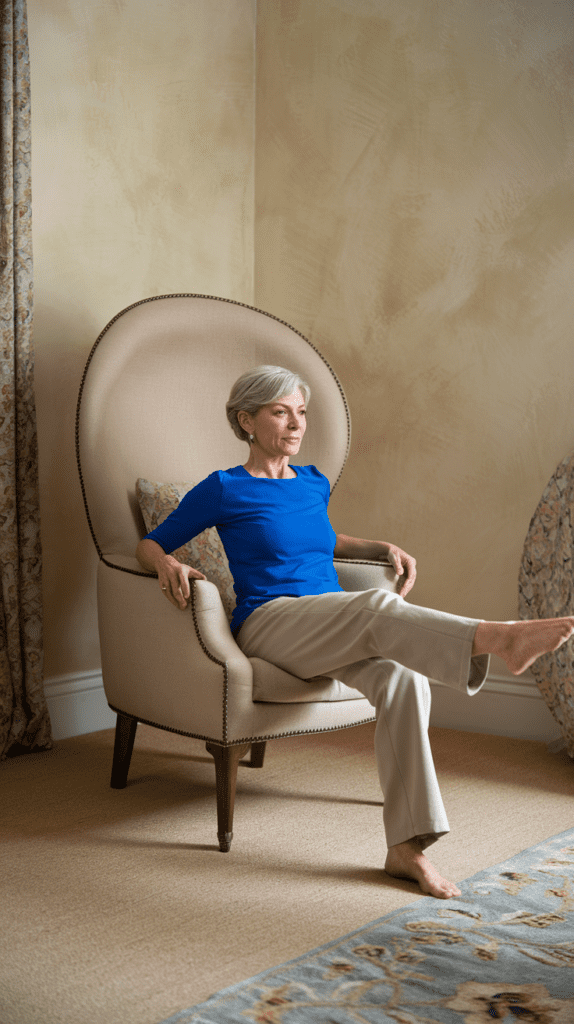
What It Is: A simple seated move strengthens your thighs and improves leg mobility.
How to Do It:
- Sit upright in a sturdy chair with both feet flat on the ground.
- Straighten your right leg out in front of you and hold for 2–3 seconds.
- Slowly lower it back down.
- Repeat on the left leg.
- Do 8–10 reps per leg.
Why It Helps:
- Strengthens quadriceps
- Supports knee stability
- Aids in walking and stair climbing
Make It Easier: Skip the hold and do quicker reps.
Make It Harder: Add ankle weights or increase the hold to 5 seconds.
15. Breath-Work Cool Down
What It Is: A calming practice to finish your workout and reset your nervous system.
How to Do It:
- Sit comfortably with your hands resting on your lap.
- Inhale deeply through your nose for 4 seconds.
- Hold the breath for 2–3 seconds.
- Exhale slowly through your mouth for 5–6 seconds.
- Repeat for 1–2 minutes.
Why It Helps:
- Reduces stress
- It slows your heart rate
- Grounds you after movement
Make It Easier: Breathe at your own pace—no need to count.
Make It Harder: Try box breathing: inhale, hold, exhale, hold (4 seconds each).
Turn It Into a Routine: Sample 3-Day Plan
Day 1: Strength & Stability
- Chair Squats
- Wall Push-Ups
- Side Leg Lifts
- Heel Raises
- Shoulder Rolls
Repeat the circuit 2x for 10–12 reps each.
Day 2: Core & Flexibility
- Seated Marches
- Modified Sit-Ups
- Overhead Reach
- Cat-Cow Stretch
- Breath-Work Cool Down
Stretch and move gently for 10–15 minutes.
Day 3: Cardio & Balance
- Toe Taps
- Step Touches
- Arm Circles
- Knee Extensions
- Neck Rolls
Repeat the circuit 2x with 30–60 seconds per move.
FAQ: Common Questions About Working Out as an Older Woman
How often should I do these?
3–5 times a week is a great start. Even 10 minutes helps!
Do I need equipment?
Nope! Just a chair, comfy clothes, and maybe a yoga mat.
What if I have arthritis or joint pain?
Use the seated modifications and move slowly. Always talk to your doctor before starting new routines.
Can I do this at 60, 70, or older?
Absolutely! These movements are low-impact and designed for real bodies at any age.
Is it okay if I can’t do all 15 right away?
Yes! Start with 3–5 that feel good and build from there.
Final Thoughts
You don’t need a fancy gym membership, expensive gear, or a personal trainer to stay strong and active.
You need a little space, a few minutes, and the belief that your body deserves to move and feel good—at any age.
Gentle movement is powerful.
Remember that it’s never too late to care for yourself, one stretch, squat, or breath at a time.




